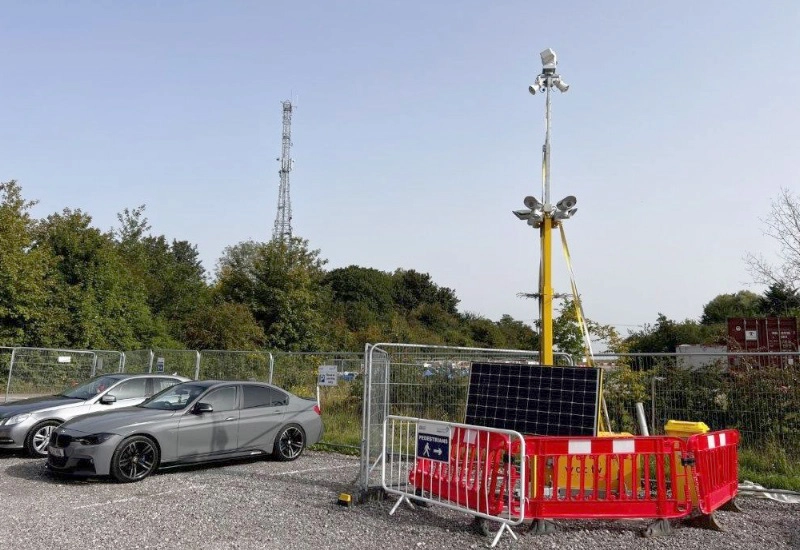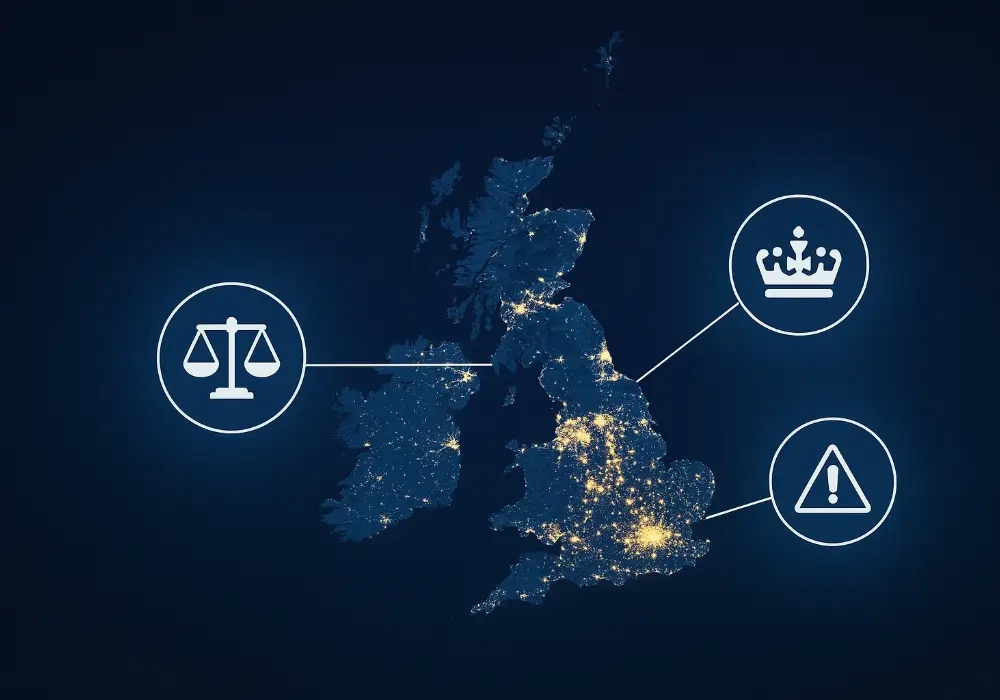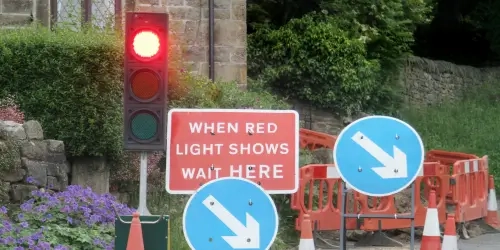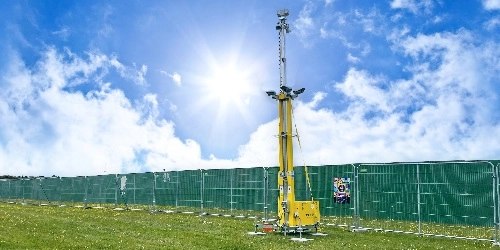Effective Temporary Traffic Management (TTM) keeps road works, maintenance projects and highway upgrades running smoothly and efficiently across the UK. This upkeep is essential for maintaining our road network, but it comes with complex safety and compliance challenges.
This is where regulatory frameworks become indispensable. Under Highways England's GG 117 and the Department for Transport's Traffic Signs Manual, all TTM activities must meet strict safety and design standards that protect everyone involved.
But for many contractors, planners and local authorities, keeping up with these regulations can be almost impossible. With evolving safety standards and multiple guidance documents to consider, it's not always clear how they fit together into practice.
In this guide, we explore what GG 117 means for safe TTM planning, why it matters and how you can make sure your projects stay fully compliant, without getting lost in regulatory complexity.
What is GG 117?
GG 117 is a key safety standard issued by National Highways that defines how temporary traffic management and road works should be designed and implemented across the UK. This standard replaced older guidelines like Chapter 8 of the Traffic Signs Manual.
GG 117 brings together the latest best practices for managing traffic safely and efficiently, particularly on motorways and high-speed dual carriageways where speed limits exceed 50 mph.
As part of the Design Manual for Roads and Bridges (DMRB), GG 117 sets out detailed requirements to ensure TTM plans are planned, executed and monitored in a way that keeps both workers and road users safe. It applies to all motorways, highways and major road maintenance or construction projects in England, Wales, Scotland and Northern Ireland.
The main goal of GG 117 is to:
- Minimise risk to all road users and site workers.
- Maintain traffic flow and reduce disruption.
- Ensure compliance with national safety and design standards.
- Integrate risk assessment and monitoring into all TTM stages.
Why GG 117 matters
GG 117 matters because it saves lives and prevents chaos on Britain's roads.
-
Protects road users and workers: GG 117 provides a standardised risk-based framework for designing and managing road construction sites. From signage placement to safety zone dimensions, it helps guide drivers safely through work zones and keeps workers out of harm's way.
-
Ensures regulatory compliance: GG 117 ensures all temporary road projects comply with the Construction (Design and Management) CDM Regulations 2015, the Traffic Signs Regulations and General Directions (TSRGD) 2016 and the Health and Safety at Work Act 1974.
-
Traffic management: By standardising temporary traffic management, GG 117 helps streamline road works, making them more efficient across all projects. This consistency reduces driver confusion, delays and safety risks.
For local authorities, contractors and transport planners, GG 117 compliance is a contractual requirement that directly impacts project approval, worker safety and legal liability. Non-compliance can result in project delays, increased insurance costs and potential prosecution under health and safety legislation.
6 GG 117 Requirements to Remain Compliant in The UK
GG 117 outlines how road works and TTM must be designed and implemented to be safe, efficient and compliant in the UK. Here's what it means in practice:
1. Risk assessment and planning
A mandatory risk assessment is required for every TTM layout. Designers must identify, evaluate and document all risks to road workers, road users (motorists, pedestrians, cyclists), emergency services and the public.
Design planning must consider traffic volumes, road layouts and project duration, and comply with GG 104 (Safety Risk Assessment), Health and Safety at Work Act 1974 and CDM Regulations 2015.
These assessments must include:
-
Site layout overview and configuration of work zones.
-
Site-specific hazards and who might be harmed (pedestrians, workers, motorists).
-
Traffic control measures designed to reduce risk to an “as low as reasonably practicable” (ALARP) level, such as cones, traffic signals and "stop-go" systems, for managing lane closures, diversions and site access points.
-
How risks will be monitored and reviewed (e.g., CCTV, smart detection systems).
2. Traffic management and design
GG 117 requires all road works to be consistent, safe and predictable, giving drivers sufficient warning of what lies ahead. These layouts must adhere to the DMRB and Traffic Signs Manual (TSM) guidelines.
Designs should account for everything on site, including lane closures (single, double, and/or multiple), crossovers, pedestrian crossings, cycle lanes and nearby intersections. Traffic management planners must also consider traffic volumes, road types and gradients, weather conditions and visibility to maintain safe operation under all circumstances.
Key factors to consider include:
-
Taper length and merge distances
-
Warning sign spacing
-
Safe stopping distances
Visible traffic management controls reinforce site restrictions, reduce driver confusion and prevent unauthorised access, mitigating accidents and unnecessary traffic delays.
3. Speed management
Temporary speed limits are essential for protecting both drivers and road workers, but they should be risk-assessed and justified, not applied automatically.
Speed limits on high-speed roads typically range from 40-70 mph, depending on:
-
Road layout and lane width
-
Worker proximity to live traffic
-
Presence of barriers or Vehicle Restraint Systems (VRS)
Common speed management measures include:
-
Speed cameras
-
Lane management techniques with clear signage
-
Police enforcement
-
Temporary CCTV solutions with advanced in-built software and AI-video analytics
Maintaining adequate vehicle separation distances is also crucial to prevent rear-end collisions and ensure overall site safety.
Read more: AI-Powered Detection on High-Speed Roads
4. Safety zones, barriers and worker protection
GG 117 requires sufficient physical separation between road workers and live traffic, often referred to as the "minimum safety zone dimensions". These zones, demarcated with cones and markers, help reduce the risks workers face with live traffic. The requirements for safety zones vary by:
-
Road speed
-
Traffic volume
-
The type of road works performed (fixed vs mobile sites)
Vehicle Restraint Systems (VRS) or temporary barriers must be used where the rate of collisions/accidents is high. UK authorities use the Road Restraints Risk Assessment Process (RRRAP) to determine whether VRS installations are required and, if so, what length and specification are needed.
Impact Protection Vehicles (IPVs) are specialised, highly visible trucks designed to protect roadside workforces in the event of a vehicle collision. Equipped with crash-absorbing materials, IPVs act as a protective "shield" on high-speed roads, protecting workers from oncoming traffic. In the UK, all IPVs must comply with the TD 49/07 standard, which specifies when and how IPVs are used.
5. Signage, lighting and visibility
Clear signage guides drivers safely through construction and maintenance zones.
As per GG 117 standards, all signs must comply with the Traffic Signs Regulations and General Directions 2016 (TSRGD), which provide the legal framework for how signs and road markings are used on public roads. The TSRGD outlines the design, appearance and placement of traffic signage across England, Scotland and Wales, ensuring national consistency and compliance.
Advance warning signs must be positioned far enough ahead of drivers, roughly 800 metres before the IPV, giving drivers enough time to adjust their speed and react safely to any upcoming changes.
Signage visibility is equally important. Signs must be illuminated and easily readable at night, in low light or during bad weather conditions. Additional visibility measures, such as EMCC (Enhanced Mobile Carriageway Closure) vehicles, help create temporary traffic-free zones for up to 9 minutes at road works on motorways and dual carriageways by controlling and slowing traffic.
In summary, road work signage must be:
-
Clear, concise and correctly sized for the road type and speed (see table below).
-
Clean, visible and free from obstructions.
-
Ordered logically (e.g., advance warning, direction, confirmation).
| Road Environment | Recommend Sign Size (mm) | Visibility & Placement Considerations |
| Urban Areas | 450-600 |
|
| Rural Roads | 750-900 |
|
| Motorways | 1200+ |
|
6. Monitoring, review and continuous improvement
TTM plans must be checked regularly throughout all project phases to remain effective and compliant.
A Traffic Safety and Control Officer (TSCO) plays a key role in this process. They're responsible for managing how traffic is controlled around worksites, from planned road works and large events to incident responses and new construction developments. Their oversight keeps traffic moving safely and efficiently at all times.
The process typically involves 3 main stages:
-
Monitoring: Regular inspections of work sites and ongoing TTM operations. This includes checking traffic flows, signage and compliance protocols (e.g., PPE, health and safety, etc.).
-
Review: Under GG 117, the TSCO must identify, record and log all incidents, disruptions, accidents and near misses as part of a post-scheme review. This provides transparency while helping build an incident database.
-
Continuous improvement: Findings from monitoring and review are used to update and upgrade existing TTM plans and risk assessments. This ongoing process helps improve safety, efficiency and compliance for future projects.
How WCCTV Supports GG 117 Compliance
Here's how our fully-managed service helps contractors, local authorities and planners remain compliant with GG 117 and other regulatory obligations in the UK:
Traffic Management Towers
Our Traffic Management Towers are purpose-built for highway and carriageway environments.
-
Rapid deployment and mobility: Basic setups can be installed within 20 minutes, providing surveillance when you need it most. Our mobile CCTV Towers can be easily repositioned as work zones change, ensuring 24/7 day-to-night oversight.
-
Autonomous operation: Powered by a mix of solar energy and fuel cell batteries, they provide continuous operation for up to 20 weeks without mains electricity or Wi-Fi, ideal for all highway types.
-
AI-powered detection: In-built video analytics identify stationary vehicles, congestion, unauthorised access, dangerous obstructions and reckless behaviour in real-time, supporting GG 117 worker safety and monitoring requirements.
-
Near-360° coverage: High-definition PTZ (Pan-Tilt-Zoom) cameras with infrared (IR) night vision, thermal imagery and up to 40X zoom capabilities monitor entire work zones regardless of lighting or weather conditions. Footage is captured in 1080p HD detail, which is used to support internal reviews, audits and insurance claims.

24/7 Remote monitoring
Our remote monitoring services deliver professional project oversight from NSI Gold Accredited monitoring facilities. Here, trained personnel:
-
Assess threats in real-time, initiating immediate response protocols.
-
Issue live voice-down audio challenges to deter intruders and unauthorised access.
-
Dispatch mobile keyholding teams to investigate verified incidents.
-
Contact emergency services if needed.
-
Provide time-stamped reports for incident reporting and peace of mind.
This active monitoring aligns with GG 117's requirements for protecting road workers and maintaining safe working environments.
Centralised management platform
Our Stellifii cloud-based platform centralises security operations across work sites, giving local authorities and contractors a single point of access from any device. Features include:
-
Remote access to live and recorded footage from any device.
-
Automated diagnostics and system health checks.
-
Incident reporting (ESG, PPE, security, etc.) with searchable, time-stamped timelines.
This centralised approach helps contractors demonstrate due diligence and compliance through comprehensive documentation and audit trails. Stellifii aligns with GG 117 requirements by supporting monitoring and review processes, documenting every stage. It's also fully GDPR-compliant, providing secure data handling and storage across all operations.
Additional security solutions
We support TTM safety with additional technologies, such as:
-
Body Cameras: Provide worker safety monitoring and incident evidence for post-scheme reviews.
-
ANPR Cameras: Track vehicle movements and identify suspicious activity across roadside sites.
-
Environment monitoring: Supports ESG compliance for noise, CO₂ and weather monitoring.
Navigate GG 117 Compliance the Smart Way
Navigating the UK's GG 117 shouldn't be overwhelming when you have WCCTV on your side. By combining proven TTM techniques with advanced CCTV surveillance systems, you can improve site safety, cut costs and streamline compliance much more easily.
Our mobile security solutions deliver professional-grade protection that costs up to 88% less than traditional security methods. With 6 regional hubs and over 20-years of experience in wireless security, we understand the unique challenges of highway security and GG 117 compliance.
Navigate GG 117 compliance the smart way.
FAQs
When did GG 117 come into effect?
GG 117 came into effect in February 2024.
What kinds of temporary traffic management techniques does GG117 include?
GG 117 covers a range of TTM techniques to keep road works safe and efficient. These include the use of EMCCs, signage, road markings, lane management strategies and risk assessments.
Are there specific requirements for signage under GG 117 in the UK?
Under GG 117, road signage must comply with the Traffic Signs Regulations and General Directions 2016 (TSRGD). This means signage must be clear, highly visible and placed correctly to provide advance warning to all road users.



